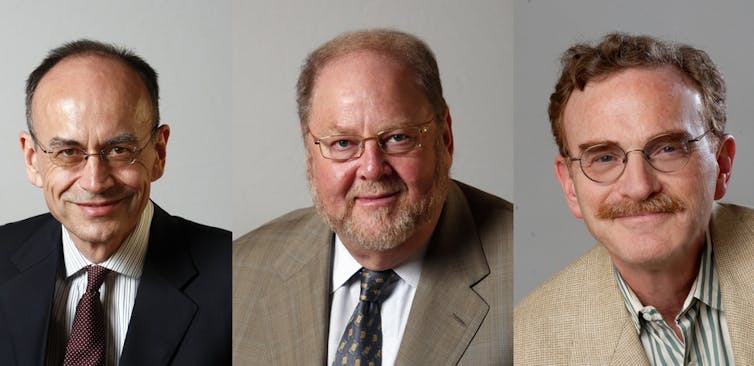What do bread, beer and botox have in common with this year’s Nobel Prize in Physiology and Medicine? More than you might think. But more on that in a minute.
The 2013 Nobel Prize in Physiology or Medicine was awarded jointly to James Rothman, Randy Schekman, and Thomas Südhof “for their discoveries of machinery regulating vesicle traffic, a major transport system in our cells.”
Long before humans organised information superhighways, developed road, rail and air networks, or established postal delivery systems, simple yeast cells had already crafted their own complex networks for delivering cargo. The cellular network embraces all the principles of an intricately designed trafficking system including careful packaging, cargo quality control, and delivery of cargo to the right address at the right time.
Randy Schekman performed his seminal work in this field in the 1970s and 1980s. He discovered the genes responsible for cargo delivery in a strain of yeast, Saccharomyces cerevisiae. This organism, also known as baker’s yeast or brewer’s yeast (used to make bread and beer) is the workhorse of genetics labs, a fundamentally important tool for physiological discovery.

By studying cargo trafficking mutants in S. cerevisiae, Schekman mapped out the machinery that packages and delivers cellular cargo.
What he didn’t know at the time – as is often the case with fundamental curiosity-driven research - was that his discoveries in this humble organism would have important implications for human disease including diabetes, neurodegenerative disease (such as Parkinson’s, Alzheimer’s and Huntington’s) and immune disorders.
The ground-breaking research performed by Jim Rothman was the discovery in mice of the critical trafficking molecules found on cargo vesicles and target membranes. In research that he performed in the 1980s and 1990s, Rothman showed that these trafficking molecules zipper together to form a complex. This zippering allows the cargo-containing vesicle to fuse with the target compartment and release its contents in a precise manner at the correct destination.
Rothman’s work identified that membrane trafficking machinery is evolutionarily conserved in higher organisms, humans included. Essentially the same molecular apparatus for vesicle trafficking in yeast is present in all our cells.
These incredibly complex systems respond to precise biological triggers (such as a change in blood glucose levels, detection of an invading virus, and so on) by trafficking specific cargo-containing packages (vesicles) to their target compartments. There, the cargo (for example, insulin in pancreatic cells, or virus-fighting molecules in immune cells) is delivered by fusing the vesicle membrane to the target membrane.

Vesicle trafficking is also absolutely essential for nervous system operation. How do nerve cells communicate? One nerve cell signals to another by releasing chemicals (neurotransmitters) that act as molecular triggers. This vesicle trafficking process must be exquisitely timed to ensure that the chemical signals are not released inappropriately.
Thomas Südhof’s powerful contribution to this field in the 1990s was the identification of the crucial triggering mechanism that precisely times the delivery of neurotransmitter cargo.
Südhof showed that calcium influx in nerve cells is detected by calcium-sensitive molecules on the vesicle. In response to this specific trigger, neurotransmitter-containing vesicles fuse with the cell membrane to release their cargo. The released neurotransmitters then signal to an adjacent neuron, beginning a new cycle of signal detection and response.
Oh, and the Botox? Botox or botulinum toxin is a poisonous molecule produced by bacteria that acts like a pair of molecular scissors. It destroys the molecules of the vesicle trafficking machinery in nerve cells. The end-effect of botulinum toxin activity is that neurotransmitters are no longer delivered in response to incoming signals. This causes paralysis.

Many disease processes are a consequence of failure of cargo delivery. Diabetes, for example, can result when the cells of the pancreas don’t release insulin or when muscle and fat cells don’t respond to insulin signalling by removing glucose from the blood. Similarly, immune disorders can occur when immune cell trafficking machinery responds inappropriately or not at all to specific immune signals.
So it’s not unexpected that these seminal findings are being recognised with the world’s greatest scientific honour - though many in the twitterverse are noting that the pundits hadn’t shortlisted them this year.
What is surprising to some is that it took so long. The Nobel prize was awarded some 30 to 40 years after the landmark papers were published. Perhaps that’s because the translational impact of such fundamental research is not immediately apparent.
Scientists are more acutely aware than ever that granting agencies are making noises about translation and impact. Many developed countries are cutting fundamental research budgets. The new Australian government, for instance, has indicated it won’t support “worthless” research and will cut the ARC budget by over A$100 million in favour of more targeted health and medical research.
Perhaps the Nobel prize committee are sending a message that fundamental curiosity-driven research has an important role to play in our future.

